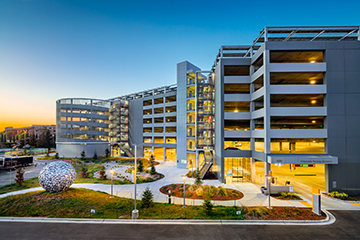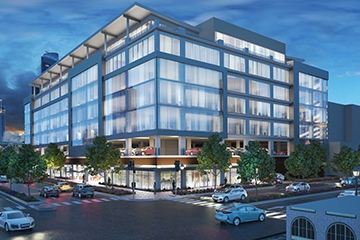Enhancing the Customer Experience: Trends in Parking Facility Design

As mobility and automation evolve, many owners are looking for ways to maximize both their short and long term investment in structured parking. What best practices should owners consider to generate additional revenue or add value for the users of their facility?
In the decade ahead, parking facilities will become more than a place to park. They will offer more amenities ranging from services to mobility hubs in order to not only drive additional revenue, but also to meet and exceed customer expectations. And parking operators will employ more marketing initiatives to drive demand and repeat customers. Let’s take a look at the top best practices to achieving these goals:
 The San Diego International Airport Terminal 2 Parking Plaza offers a loyalty program and discounts for payment in advance (Photo by Tom Paiva).
The San Diego International Airport Terminal 2 Parking Plaza offers a loyalty program and discounts for payment in advance (Photo by Tom Paiva).
Reward repeat customers: Loyalty programs already abound, from grocery stores to restaurants to retail stores, all to incentivize repeat customers. Why can’t parking do the same? Frequent parker programs, VIP spaces and special discounts are all incentives to encourage users to come back to a garage.
This can be especially effective in airports, where frequent business travelers will find tremendous value in parking incentives that can get them out of their car and to their gate quicker and more efficiently.
Improve the customer experience by creating a welcoming environment: Since parking is often the first and last impression a person has at a destination, ensuring that impression is a positive one can have a significant impact on customer satisfaction. Too many people imagine parking structures as dark, uninviting spaces that are a necessary evil. However, there are a number of ways we can change that perception.
One of those ways is through art. Be it a mural or a sculpture, or a statement piece woven into the façade, infusing parking structures with art creates a canvas that can reinforce a location’s identity.
Another way is to appeal to other senses. While we expect visual cues from parking structures, from signage and parking guidance to art and architecture, it’s not often that parking engages users through sound. Bright lighting, information kiosks to help connect users with their destinations, and even well-appointed waiting areas with seating are other ways parking can make people feel welcome.
Integrate parking guidance and revenue control systems: Level-by-level and even space-by-space parking guidance displayed via real-time, dynamic signage can help users quickly find a parking spot, eliminating unnecessary circling and idling. This in turn improves both efficiency and the user experience.
The plethora of revenue control systems available today offer options such as online reservations, dynamic pricing, preferred parking zoning and parking enforcement that can be customized to meet the individual needs of a garage. In addition, owners and operators can gain access to real-time parking data, financial reports and space management to better track both parking usage and revenue.
 Bold colors and imaginative signage enhance the user experience while improving wayfinding (Photo by Bill Timmerman).
Bold colors and imaginative signage enhance the user experience while improving wayfinding (Photo by Bill Timmerman).
Enhance wayfinding: Dynamic signage is not the only way to improve wayfinding. Bold colors, imaginative signage, color-coded pictograms and audio cues not only clearly direct both drivers and pedestrians on how to safely and efficiently navigate the structure, but can also help users remember where they parked.
Landmark features such as public art and glass-backed elevators can also serve as wayfinding devices to orient pedestrians.
Design for energy efficiency: Parking offers a number of opportunities to create sustainable infrastructure that will help shape the future of mobility. From EV charging infrastructure and photovoltaics to net zero energy, parking has made great strides in innovative, sustainable design practices.
While LEED certification is not available to standalone parking structures, the Parksmart program offered through a partnership with the US Green Building Council, is a certification system designed specifically for parking structures.
Expand service amenities: Today’s ‘Amazon’ economy puts emphasis on convenience. More and more users expect services and amenities to come to them, rather than having to seek them out. Parking facilities present a unique opportunity to provide convenience. For instance, some parking facilities provide an ambassador program designed to provide customer service for users. Office complexes can offer on-site car detailing, while retail facilities can deliver packages straight to a shopper’s car. This latter opportunity will expand rapidly with the adoption of experiential shopping.
Valet service not only provides operators with the ability to achieve greater efficiency, but they also offer an opportunity to provide services such as EV charging and even dry cleaning drop off and delivery.
 This parking structure at Menlo Gateway offers Facebook employees bicycle storage, showers, restrooms and lockers to encourage employees. A valet program also manages EV charging for electric vehicles. (Photo by Lucas Fladzinski)
This parking structure at Menlo Gateway offers Facebook employees bicycle storage, showers, restrooms and lockers to encourage employees. A valet program also manages EV charging for electric vehicles. (Photo by Lucas Fladzinski)
Create mobility hubs: As urban areas continue to densify and seek alternative forms of transportation to ease congestion, parking has an opportunity to become more than just a place to store cars. By creating mobility hubs, we open parking structures up to new ways to not only serve customers, but also drive revenue.
What will we see in mobility hubs? Bicycle parking with shower, locker and repair facilities for those who bike to work. Pick up and drop off lobbies for rideshare users and transit riders.
Like an airport or train terminal, parking structures can become places that connect people, offering lounges, retail and restaurants to make their journeys more pleasant and comfortable.
Expand pick up and drop off: When looking for ways to adapt existing parking facilities to the changing face of mobility, one of the options we can explore is modifying the existing layout to better accommodate changing uses, such as expanding pick up and drop off zones for ridesharing. This can be accomplished by re-striping an existing floor or garage to create a more functional layout.
 The new San Mateo County Government Center Parking Structure will feature a ground floor designed for adaptive reuse.
The new San Mateo County Government Center Parking Structure will feature a ground floor designed for adaptive reuse.
Design for adaptive reuse: The cost of adapting a parking facility to an alternative use can cover a wide spectrum. Both upfront costs and long-range savings should be considered when evaluating potential return on investment. Site location, value, demand and density are key factors.
At the lowest end of the cost spectrum, designing the ground level for future conversion can offer minimal impact while still providing flexibility. Beyond traditional commercial, office or residential space, parking could be converted down the line to data centers, serve as storage space or provide a hub for urban delivery staging like grocery and package delivery.
Fully designing an entire structure for adaptive reuse can increase cost by 40% or more. However, for owners who believe parking demand will decrease over time, building in flexibility could be viewed as an investment in the full life of the development. It can potentially provide a more cost effective way to reap development benefits down the road by paying for a future project in today’s dollars.
To continue to support our evolving cities, we need to continue to think outside the box about parking. We need to continue to explore new and innovative ways to meet and exceed customer expectations, which in turn generate revenue.







